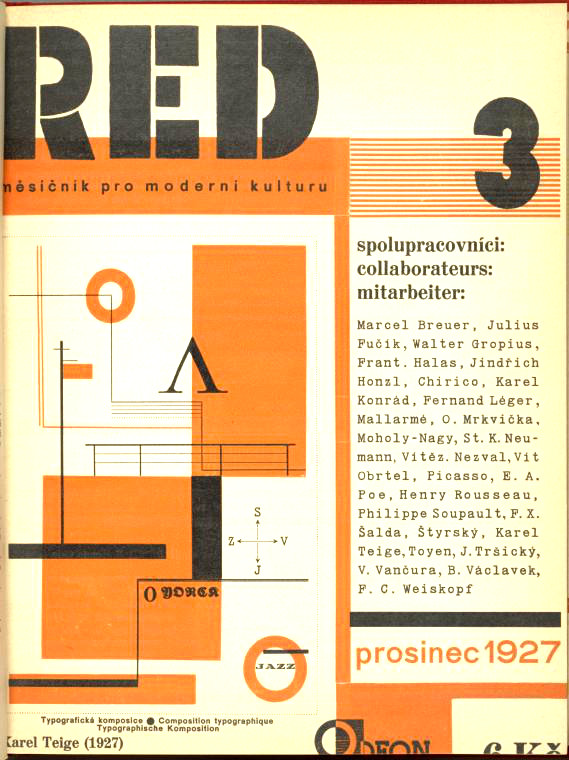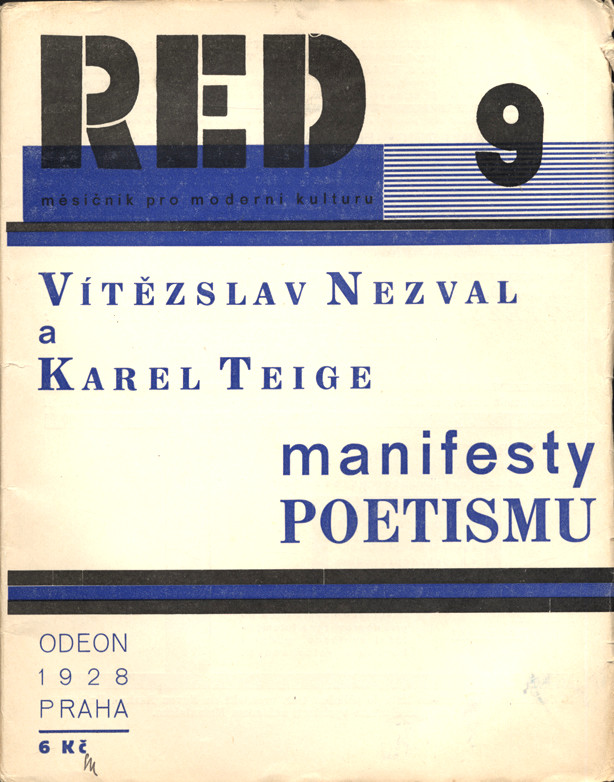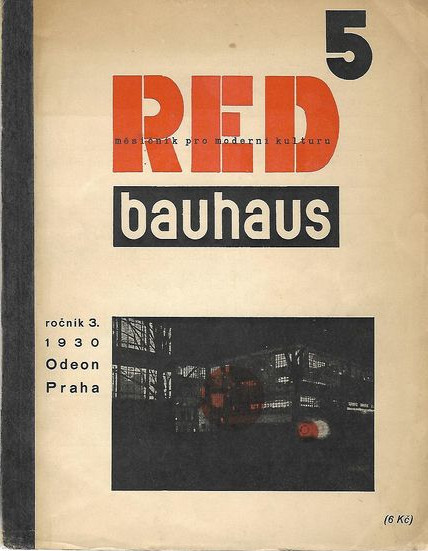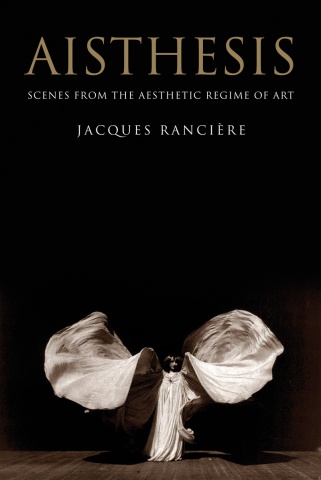ReD (Revue Devětsilu): modern culture monthly (1927-1931) [Czech]
Filed under magazine | Tags: · architecture, art, art theory, avant-garde, bauhaus, constructivism, czechoslovakia, dada, design, film, graphic design, literature, photography, poetry, psychoanalysis, radio, surrealism, theatre



ReD (měsíčník pro moderní kulturu / Revue internationale illustrée de l’activité contemporaine / Internationale Monatsschrift für moderne Gestaltung) was an art magazine published by members of the Czech avant-garde art collective Devětsil.
Thirty numbers were published, with the special issues on the Russian avant-garde, Bauhaus, and photography/film/typography.
Several manifestos appeared in the journal: Toyen and Jindřich Štyrský’s Artificielisme (1:1, 1927), Karel Teige’s second Poetism manifesto [Manifest Poetismu] (1:9, 1928), and the Left Front [Levá fronta]’s founding manifesto (3:2, 1929).
Edited and designed by Karel Teige
Publisher Odeon – Jan Fromek, Prague
via NYPL Digital Library
Each volume in a single PDF (low resolution):
Volume I, 1927-1928 (10 issues, 360 pages)
Volume II, 1928-1929 (10 issues, 324 pages)
Volume III, 1929-1931 (10 issues, 315 pages)
Selected issues in separate PDFs:
The Russian Issue (1:2, Nov 1927)
Foto Film Typo Issue (2:8, Apr 1929)
The Bauhaus Issue (3:5, Feb 1930, partly in German)
JPG pages (search in page annotations):
View online
See also Devětsil: Revoluční sborník (1922), edited by Jaroslav Seifert and Karel Teige, in Czech.
Comment (1)Jacques Rancière: Aisthesis: Scenes from the Aesthetic Regime of Art (2011/2013)
Filed under book | Tags: · aesthetics, art, art history, art theory, body, cinema, dance, film, life, literature, music, painting, pantomime, philosophy, photography, poetry, politics, representation, sculpture, theatre, theory

Rancière’s magnum opus on the aesthetic.
“Composed in a series of scenes, Aisthesis–Rancière’s definitive statement on the aesthetic–takes its reader from Dresden in 1764 to New York in 1941. Along the way, we view the Belvedere Torso with Winckelmann, accompany Hegel to the museum and Mallarmé to the Folies-Bergère, attend a lecture by Emerson, visit exhibitions in Paris and New York, factories in Berlin, and film sets in Moscow and Hollywood. Rancière uses these sites and events—some famous, others forgotten—to ask what becomes art and what comes of it. He shows how a regime of artistic perception and interpretation was constituted and transformed by erasing the specificities of the different arts, as well as the borders that separated them from ordinary experience. This incisive study provides a history of artistic modernity far removed from the conventional postures of modernism.”
First published as Aisthesis : Scènes du régime esthétique de l’art, Éditions Galilée, 2011
Translated by Zakir Paul
Publisher Verso Books, 2013
ISBN 1781680892, 9781781680896
304 pages
via falsedeity
Reviews: Hal Foster (London Review of Books), Joseph Tanke (Los Angeles Review of Books), Marc Farrant (The New Inquiry), Ali Alizadeh (Sydney Review of Books), Jean-Philippe Deranty (Parrhesia).
Roundtable discussion with Rancière at Columbia (video, 43 min)
Selected interviews and reviews (in French)
László Moholy-Nagy: Painting, Photography, Film (1925–) [DE, EN]
Filed under book | Tags: · art, art theory, bauhaus, collage, design, film, montage, painting, photogram, photography

This book presents Moholy-Nagy’s photograms, X-rays, super-wide-angle fisheye pictures, double prints, collages, montages, and the Bauhaus artist’s thoughts on the interrelationship of type, audio, and visual perception.
From the English edition: “The layout of the pages designed by Moholy-Nagy in 1927–bold sans-serif captions surrounded by lots of white space; compositions composed of arrows, dots, photographs, and heavy ruled lines — is much more like a movie storyboard or a musical score. It conveys a suggestion of imploding optical and retinal phenomena, much like driving down the Los Angeles Freeway at 70 mph or jolting through Philadelphia on the Metroliner.. This edition is a translation and facsimile of the second German edition of Malerei, Fotographie, Film published in 1927 by the Bauhaus Press; and it serves as a valuable reminder of the graphic design pioneered at the Bauhaus by Moholy-Nagy and Herbert Bayer..”
“Gropius had invited the twenty-eight-year-old Hungarian phenom onto the Bauhaus faculty in 1923, and Malerei Fotografie Film is Moholy-Nagy’s first attempt to lay out his entire theory and program for photography, and ultimately, for the transformation of human vision.. The book’s bold typography and design enacted Moholy’s concept of ‘typofoto,’ involving the integration of type and images, which was further elaborated in his two later theoretical works, Von Material zu Architektur and Vision in Motion..” (Randell Roth)
Contains photographs by Alfred Steiglitz, Albert Renger-Pazsch, L. Moholy-Nagy, Man Ray, Lucia Moholy, Hannah Hoch and others.
Publisher Albert Langen, Munich, 1925
Volume 8 of Bauhausbücher series
Second edition, 1927
140 pages
via Bibliothèque Kandinsky
English edition
With a Note by Hans M. Wingler, and a Postcript by Otto Stelzer
Translated by Janet Seligman
Publisher Lund Humphries, London, 1969
150 pages
via Sorin Danut
Malerei, Fotografie, Film (German, 2nd ed., 1925/1927, 131 MB, via Bibliothèque Kandinsky, updated on 2022-4-13)
Malerei, Fotografie, Film (German, 2nd ed., 1925/1927, PDF, JPG, in Heidelberg U Library, added on 2019-7-7)
Painting, Photography, Film (English, trans. Janet Seligman, 1969, added on 2014-8-17)
See also other titles in Bauhaus Books series.
Comments (6)
